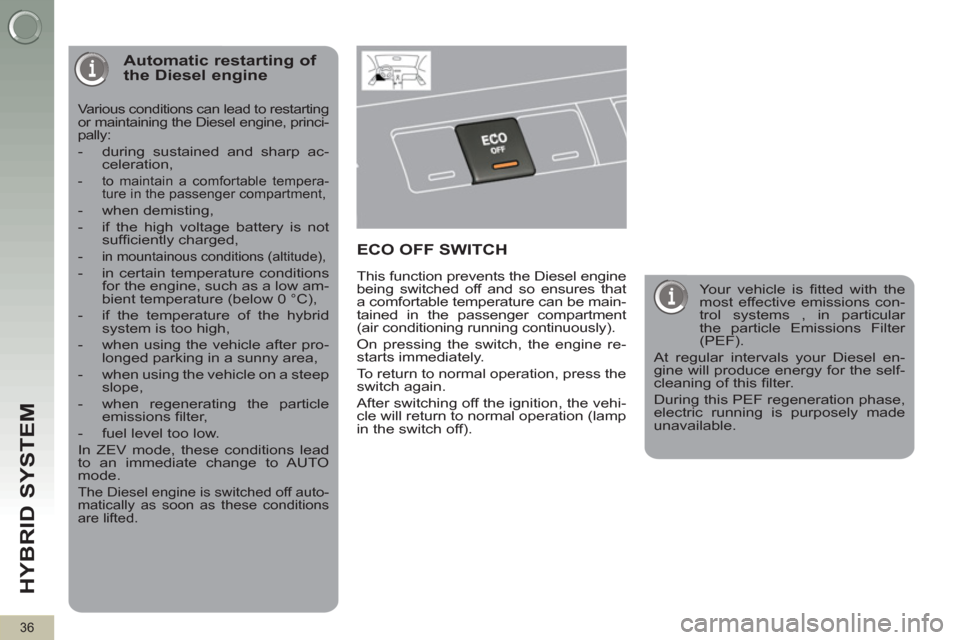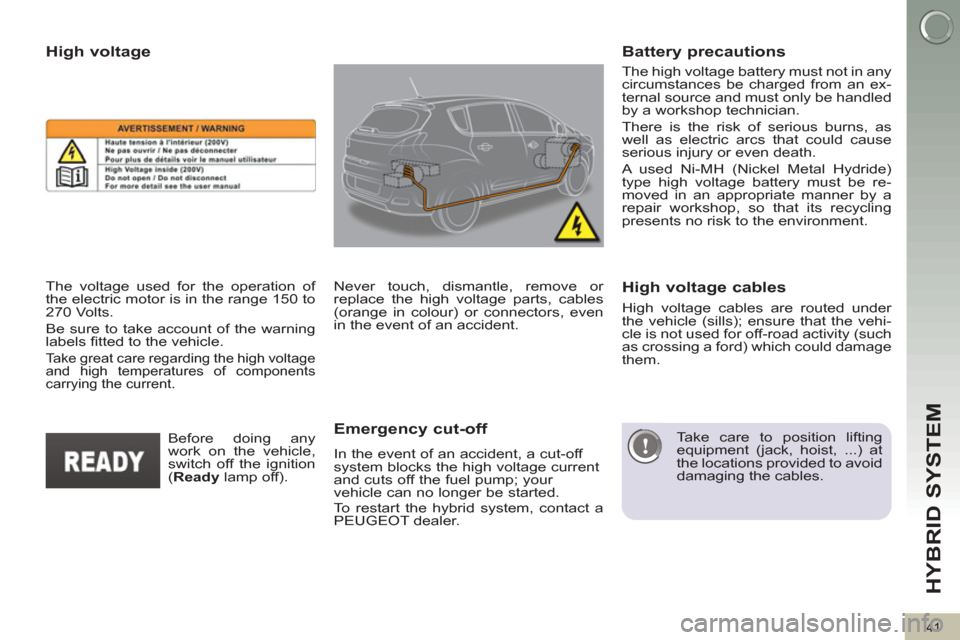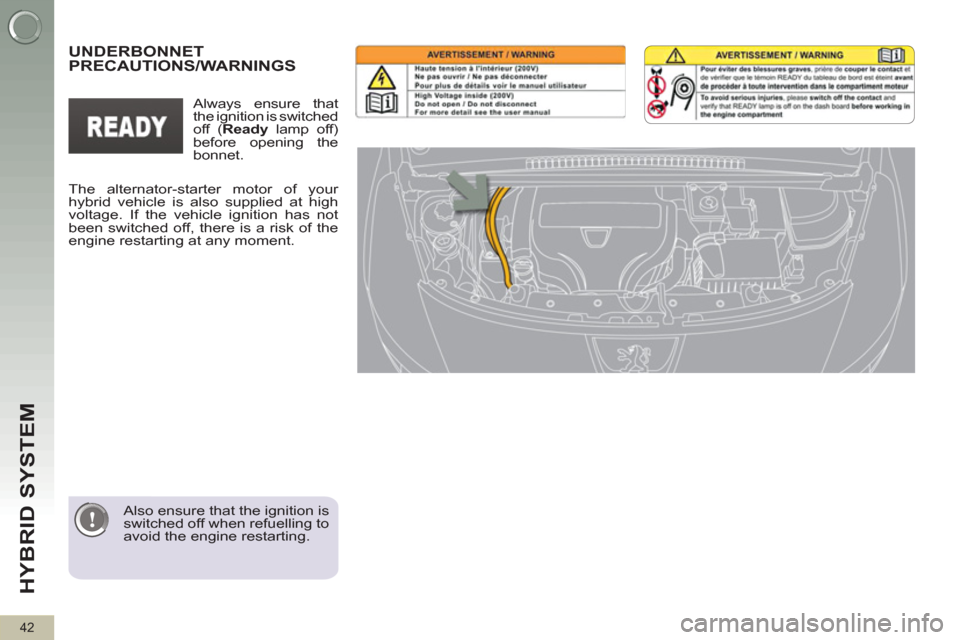2012 Peugeot 3008 Hybrid 4 fuel
[x] Cancel search: fuelPage 38 of 284

HYBRID SYSTEM
36
Automatic restarting of
the Diesel engine
Various conditions can lead to restarting
or maintaining the Diesel engine, princi-
pally:
- during sustained and sharp ac-
celeration ,
- to maintain a comfortable tempera-
ture in the passenger compartment,
- when demisting,
- if the high voltage battery is not
suffi ciently charged,
-
in mountainous conditions (altitude),
- in certain temperature conditions
for the engine, such as a low am-
bient temperature (below 0 °C),
- if the temperature of the hybrid
system is too high,
- when using the vehicle after pro-
longed parking in a sunny area,
- when using the vehicle on a steep
slope,
- when regenerating the particle
emissions fi lter,
- fuel level too low.
In ZEV mode, these conditions lead
to an immediate change to AUTO
mode.
The Diesel engine is switched off auto-
matically as soon as these conditions
are lifted.
ECO OFF SWITCH
This function prevents the Diesel engine
being switched off and so ensures that
a comfortable temperature can be main-
tained in the passenger compartment
(air conditioning running continuously).
On pressing the switch, the engine re-
starts immediately.
To return to normal operation, press the
switch again.
After switching off the ignition, the vehi-
cle will return to normal operation (lamp
in the switch off).
Your vehicle is fi tted with the
most effective emissions con-
trol systems , in particular
the particle Emissions Filter
(PEF).
At regular intervals your Diesel en-
gine will produce energy for the self-
cleaning of this fi lter.
During this PEF regeneration phase,
electric running is purposely made
unavailable.
Page 39 of 284

HYBRID SYSTEM
37
ECO-DRIVING
Eco-driving is a range of everyday practices that allow the motorist to optimise their fuel consumption and CO2 emis-
sions.
Optimise the use of your
gearbox
Use automatic mode A
as much as
possible as this optimises gear chang-
es to suit the circumstances.
Drive smoothly
If your vehicle has cruise control, make
use of the system at speeds above
25 mph (40 km/h) when the traffi c is
fl owing well.
Control the use of your electrical equipment
Before moving off, if the passenger
compartment is too warm, ventilate it by
opening the windows and air vents be-
fore using the air conditioning.
Above 30 mph (50 km/h), close the win-
dows and leave the air vents open.
Remember to make use of equipment
that can help keep the temperature in
the passenger compartment down (sun
roof and window blinds...).
Switch off the air conditioning, unless
it has automatic digital regulation, as
soon as the desired temperature is at-
tained.
Switch off the demisting and defrosting
controls, if not automatic.
Switch off the heated seat as soon as
possible.
Switch off the headlamps and front fo-
glamps when the level of light does not
require their use.
Avoid running the Diesel engine when
stationary, particularly in winter; your
vehicle will warm up much faster while
driving.
As a passenger, if you avoid connecting
your multimedia devices (fi lm, music,
video game...), you will contribute to-
wards limiting the consumption of elec-
trical energy, and so of fuel.
Disconnect your portable devices be-
fore leaving the vehicle.
Maintain a safe distance between ve-
hicles, use engine braking rather than
the brake pedal, and press the accel-
erator progressively. These practices
contribute towards a reduction in fuel
consumption and CO
2 emissions and
also helps reduce the background traf-
fi c noise.
Page 40 of 284

HYBRID SYSTEM
38
Limit the causes of excess
consumption
Spread loads throughout the vehicle;
place the heaviest items in the bottom
of the boot, as close as possible to the
rear seats.
Limit the loads carried in the vehicle
and reduce wind resistance (roof bars,
roof rack, bicycle carrier, trailer...). Use
a roof box in preference.
Remove roof bars and roof racks after
use.
At the end of winter, remove snow
tyres and refi t your summer tyres.
Observe the recommendations
on maintenance
Check the tyre pressures regularly,
when cold, referring to the label in the
door aperture, driver's side.
Carry out this check in particular:
- before a long journey,
- at each change of season,
- after a long period out of use.
Have your vehicle serviced regularly
(engine oil, oil fi lter, air fi lter...) and
observe the schedule of operations
recommended by the manufacturer.
When refuelling, do not continue after
the 3 rd cut-off of the nozzle to avoid
any overfl ow.
At the wheel of your new vehicle, it is only
after the fi rst 1 800 miles (3 000 kilometres)
that you will see the fuel consumption set-
tle down to a consistent average.
Page 43 of 284

HYBRID SYSTEM
41
The high voltage battery must not in any
circumstances be charged from an ex-
ternal source and must only be handled
by a workshop technician.
There is the risk of serious burns, as
well as electric arcs that could cause
serious injury or even death.
A used Ni-MH (Nickel Metal Hydride)
type high voltage battery must be re-
moved in an appropriate manner by a
repair workshop, so that its recycling
presents no risk to the environment.
High voltage
The voltage used for the operation of
the electric motor is in the range 150 to
270 Volts.
Be sure to take account of the warning
labels fi tted to the vehicle.
Take great care regarding the high voltage
and high temperatures of components
carrying the current.
Emergency cut-off
In the event of an accident, a cut-off
system blocks the high voltage current
and cuts off the fuel pump; your
vehicle can no longer be started.
To restart the hybrid system, contact a
PEUGEOT dealer. Never touch, dismantle, remove or
replace the high voltage parts, cables
(orange in colour) or connectors, even
in the event of an accident.
High voltage cables are routed under
the vehicle (sills); ensure that the vehi-
cle is not used for off-road activity (such
as crossing a ford) which could damage
them.
Before doing any
work on the vehicle,
switch off the ignition
( Ready
lamp off).
Battery precautions
High voltage cables
Take care to position lifting
equipment (jack, hoist, ...) at
the locations provided to avoid
damaging the cables.
Page 44 of 284

HYBRID SYSTEM
42
Also ensure that the ignition is
switched off when refuelling to
avoid the engine restarting.
UNDERBONNET
PRECAUTIONS/WARNINGS
The alternator-starter motor of your
hybrid vehicle is also supplied at high
voltage. If the vehicle ignition has not
been switched off, there is a risk of the
engine restarting at any moment.
Always ensure that
the ignition is switched
off ( Ready
lamp off)
before opening the
bonnet.
Page 46 of 284

44
INSTRUMENTS and CONTROLS
Panel grouping together the vehicle operation indication dials and warning lamps.
INSTRUMENT PANELS
For more information, refer to
the paragraph relating to the
button or function and its as-
sociated display.
Dials
6.
Display zero reset or service indi-
cator re-display button.
Resets the selected function to zero
(trip distance recorder or service in-
dicator) or displays the service indi-
cator again.
7.
Instrument panel lighting dimmer.
Adjusts the brightness of the lighting
of the instruments and controls, if the
vehicle lighting is on.
8.
Ready lamp
Indicates that the vehicle is ready to
move off.
1.
Power meter
Indicates the power available as a
percentage .
For more information refer to the
"Hybrid" section.
2.
Coolant temperature gauge.
Indicates the temperature of the
engine coolant (° Celsius).
3.
Fuel gauge.
Indicates the quantity of fuel remaining
in the tank.
4.
Speedometer.
Indicates the current speed of the
moving vehicle (mph or km/h).
5.
Screen.
Screen(s)
A.
Speed limiter
or
Cruise control.
(mph or km/h)
B.
Trip distance recorder.
(miles or km)
C.
Service indicator.
(miles or km) or,
Engine oil level indicator.
or
Distance recorder.
(miles or km)
D.
6-speed electronic gear control
gearbox.
E. - Electrical fl ow or
- Warning messages and function
status messages or
- Trip computer or
- Satellite navigation information or
-
Menus (with Peugeot Connect
Media Navigation (NG4 3D)).
Page 48 of 284

46
INSTRUMENTS and CONTROLS
Vehicle parameters
This menu allows you to activate or
deactivate certain driving and comfort
equipment (according to country):
- wiper linked with reverse gear (refer
to the "Visibility" section),
- selective unlocking (refer to the "Ac-
cess" section),
- guide-me-home and welcome lighting
(refer to the "Visibility" section),
- interior mood lighting (refer to the
"Visibility" section),
- daytime running lamps (refer to the
"Visibility" section),
- directional headlamps (refer to the
"Visibility" section),
- automatic or manual parking brake
(refer to the "Driving" section).
Choice of units
This menu allows you to select the
units: temperature (°Celsius or °Fahr-
enheit) and fuel consumption (l/100 km,
mpg or km/l).
Choice of language
This menu allows you to select the
display language: Deutsch, English,
Espanol, Français, Italiano, Nederlands,
Portugues, Türkçe * .
*
According to country.
Indicator and warning lamps
Visual indicators informing the driver
that a system is in operation (operation
or deactivation indicator lamps) or of the
occurrence of a fault (warning lamp).
When the ignition is switched on
Certain warning lamps come on for a
few seconds when the vehicle's ignition
is switched on.
When the engine is started, these same
warning lamps should go off.
If they remain on, before moving off,
refer to the information on the warning
lamp concerned.
Associated warnings
The illumination of certain warning
lamps may be accompanied by an au-
dible signal and a message in the multi-
function screen.
The warning lamps may come
on continuously (fi xed) or fl ash.
Certain warning lamps may
come on in two different modes. Only
by relating the type of illumination to
the operating status of the vehicle
can it be ascertained whether the
situation is normal or whether a fault
has occurred.
Page 54 of 284

52
INSTRUMENTS and CONTROLS
Warning lamp
is on
Cause
Action/Observations
Engine
autodiagnosis
system
fl ashing. The engine management
system has a fault.
Risk of destruction of the catalytic converter.
Have it checked by a PEUGEOT dealer or
a qualifi ed workshop.
fi xed. The emission control system
has a fault. The warning lamp should go off when the
engine is started.
If it does not go off, contact a PEUGEOT
dealer or qualifi ed workshop without delay.
Low fuel
level
fi xed with the needle
in the red zone. When it fi rst comes on there
remains approximately
6 litres
of fuel in the tank.
At this point, you begin to
use the fuel reserve.
Refuel as soon as possible to avoid
running out of fuel.
This warning lamp will come on every time
the ignition is switched on, until a suffi cient
addition of fuel is made.
Fuel tank capacity: approximately 56.5 litres
.
Never continue to drive until you run out of fuel, as this
could damage the emission control and injection systems.
Maximum
coolant
temperature
fi xed with the needle
in the red zone. The temperature of the
cooling system is too high. Stop as soon as it is safe to do so.
Wait until the engine has cooled down
before topping up the level, if necessary.
If the problem persists, contact a PEUGEOT
dealer or a qualifi ed workshop.
Dynamic
stability
control
(DSC/ASR)
fl ashing. The DSC/ASR regulation is
active. The system optimises traction and improves
the directional stability of the vehicle.
fi xed. Unless it has been
deactivated (button pressed
and its indicator lamp on) the
DSC/ASR system has a fault. Have it checked by a PEUGEOT or a
qualifi ed workshop.
Anti-lock
Braking
System
(ABS)
fi xed. The anti-lock braking system
has a fault. The vehicle retains conventional
braking.
Drive carefully at reduced speed
and contact a PEUGEOT dealer or a
qualifi ed workshop without delay.